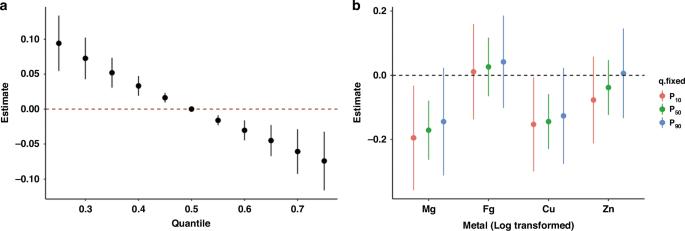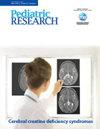全血必需金属与学龄前儿童神经发育的关系
IF 3.1
3区 医学
Q1 PEDIATRICS
引用次数: 0
摘要
背景:必需金属可能在神经发育中发挥作用。研究旨在评估学龄前儿童体内镁(Mg)、铁(Fe)、铜(Cu)和锌(Zn)水平与神经发育的关系:对2019年1月至2022年7月期间入组的合格儿童的病历进行回顾性审查,以获取所需的信息。使用原子吸收光谱对金属进行定量测量,同时使用年龄与阶段问卷对神经发育进行筛查。采用修正泊松回归和贝叶斯核机回归(BKMR)分析来评估其独立和联合关联的患病率比(PR):结果:662 名(14.8%)儿童可能存在神经发育迟缓。修正泊松回归显示,镁、铜和锌水平与神经发育迟缓风险呈独立负相关。上述金属每对数2增量的PR值(95% CI)分别为0.35(0.19-0.62)、0.57(0.42-0.77)和0.63(0.42-0.96)。在考虑具体的五个领域时,这些负相关在粗大运动和个人-社会领域更为明显。BKMR显示,金属混合物与神经发育迟缓的风险呈负相关:结论:镁、铜和锌与神经发育迟缓成反比。充足的必需金属水平对神经发育非常重要:影响:必需金属在神经发育中起着关键作用。有关必需金属混合物与神经发育关系的研究相对较少。研究发现,可能存在神经发育迟缓的学龄前儿童体内的镁、铜和锌含量低于同龄儿童。单一的镁、铜和锌水平以及必需金属混合物的升高与可能出现神经发育迟缓的风险呈负相关。本文章由计算机程序翻译,如有差异,请以英文原文为准。

Association of whole blood essential metals with neurodevelopment among preschool children
Essential metals may play roles in neurodevelopment. The aim was to evaluate the associations of magnesium (Mg), iron (Fe), copper (Cu), and zinc (Zn) levels with neurodevelopment among preschool children. The medical records of eligible children enrolled between January 2019 and July 2022 were retrospectively reviewed for required information. The quantitative measurement of metals was conducted using atomic absorption spectroscopy, while screening of neurodevelopment was performed using the Ages and Stages Questionnaire. Modified Poisson regression and Bayesian kernel machine regression (BKMR) analyses were used to evaluate the prevalence ratio (PR) of their independent and joint associations. 662 (14.8%) children were found to have possible neurodevelopmental delays. Modified Poisson regression showed that Mg, Cu, and Zn levels were independently and negatively associated with the risk of neurodevelopmental delay. The PRs (95% CIs) for per log2 increment of the above metals were 0.35 (0.19–0.62), 0.57 (0.42–0.77), and 0.63 (0.42–0.96). These negative associations were more pronounced in the gross motor and personal-social domains while considering the concrete five domains. BKMR showed a negative association of metal mixture with the risk of neurodevelopmental delay. Mg, Cu, and Zn were inversely associated with neurodevelopmental delay. Sufficient essential metal levels are important for neurodevelopment.
求助全文
通过发布文献求助,成功后即可免费获取论文全文。
去求助
来源期刊

Pediatric Research
医学-小儿科
CiteScore
6.80
自引率
5.60%
发文量
473
审稿时长
3-8 weeks
期刊介绍:
Pediatric Research publishes original papers, invited reviews, and commentaries on the etiologies of children''s diseases and
disorders of development, extending from molecular biology to epidemiology. Use of model organisms and in vitro techniques
relevant to developmental biology and medicine are acceptable, as are translational human studies
 求助内容:
求助内容: 应助结果提醒方式:
应助结果提醒方式:


